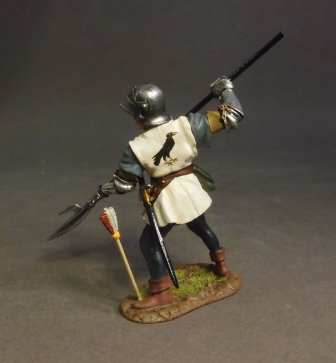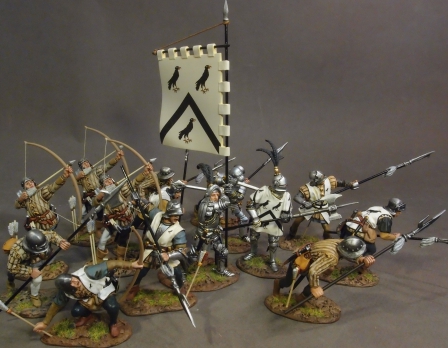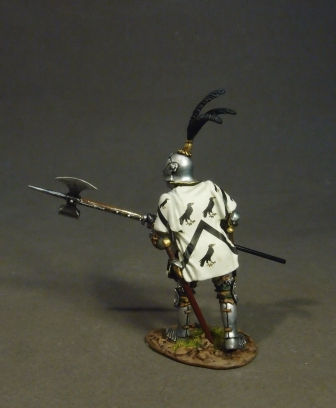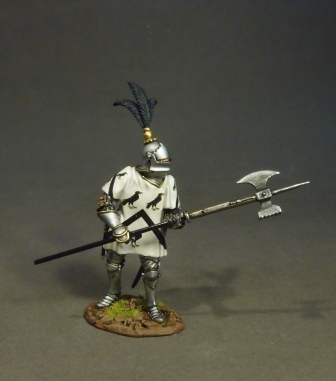 >
>
THE WARS OF THE ROSES 1455-1487
THE BATTLE OF BOSWORTH FIELD 1485
RTLANC-01
The Retinue Of Sir Rhys Ap Thomas,
Rhys Ap Thomas
(1pc)
US$48

THE WARS OF THE ROSES 1455-1487
The Wars of the Roses
were a series of dynastic wars for the throne of England.
They were fought between supporters
of two rival branches of the royal House of Plantagenet,
the houses of Lancaster and York.
They were fought in several sporadic episodes between 1455 and 1487,
although there was related fighting before and after this period.
The conflict resulted from social and financial troubles
that followed the Hundred Years' War,
combined with the mental infirmity and weak rule of Henry VI,
which revived interest in the alternative
claim to the throne of Richard, Duke of York.
The final victory went to a claimant of the Lancastrian party
, Henry Tudor, who defeated the last Yorkist king,
Richard III, at the Battle of Bosworth Field.
After assuming the throne as Henry VII,
Henry Tudor married Elizabeth of York,
the eldest daughter and heiress of Edward IV,
thereby uniting the two claims.
The House of Tudor ruled England and Wales until 1603.
THE BATTLE OF BOSWORTH FIELD 1485
The Battle of Bosworth (or Bosworth Field)
was the last significant battle of the Wars of the Roses,
the civil war between the Houses of Lancaster and York
that raged across England in the latter half of the 15th century.
Fought on 22 August 1485,
the battle was won by the Lancastrians.
Their leader Henry Tudor,
Earl of Richmond,
by his victory became the first English monarch of the Tudor dynasty.
His opponent, Richard III,
the last king of the House of York,
was killed in the battle.
Historians consider Bosworth Field to mark the end of the Plantagenet dynasty,
making it a defining moment of English and Welsh history.
LIVERIES AND BADGES
By the time of the Wars Of The Roses,
badges were of considerable importance.
These along with the Livery Colours were closely associated with what was
then known as Livery and Retaining (Bastard Feudalism).
The badges were rarely worn by their owners,
for they were marks of ownership.
They were, however, worn by his servants,
house-hold men, retainers,
and probably temporarily by the adherents to his cause.
So great and extensive was the use of these badges,
that they were far more generally employed than the coat of arms.
For where a man's badge would be
common knowledge and bear some repute throughout the kingdom,
few people would know what his coat of arms looked like.
HERALDIC BANNERS, BANNERS AND STANDARDS
There were 3 main types of flags used during the Wars of The Roses.
The largest was known as the Heraldic Banner,
and was used solely for displaying the coats of arms.
This was normally square and made with stiffened buckram with a batton along the top.
Therefore it was always on the fly,
so the standard bearer did not have to wave the banner about,
which gave him a spare hand in which he could brandish a weapon,
so he would be able to defend himself and the banner.
The Banner was a smaller version of the Heraldic Banner,
and usually only carried one large badge or device.
The field was often in the colour of the livery,
but this was not a rule.
The third type was known as a standard, and was a long swallow tailed style.
In an effort to destroy Henry Tudor,
Richard decided to leave his position on Ambion Hill,
leading his household retainers down the slope,
thundering towards Henry’s men with levelled lances.
A few of the key personalities involved in King Richard’s heroic last charge will be available in the summer.
King Richard III and his standard bearer,
Sir Percival Thirlwall,
charge towards Henry Tudor and his standard bearer William Brandon.
King Richard III (2 October 1452 – 22 August 1485) was King of England from 1483 until his death in 1485,
at the age of 32, in the Battle of Bosworth Field.
He was the last king of the House of York and the last of the Plantagenet dynasty.
His defeat at Bosworth Field, the last decisive battle of the Wars of the Roses,
marked the end of the Middle Ages in England.

Rhys ap Thomas (1449–1525),is a Welsh name meaning, Rhys son of Thomas,
and was a Welsh soldier and landholder who rose to prominence during the Wars of the Roses,
and was instrumental in the victory of Henry Tudor at the Battle of Bosworth.
He remained a faithful supporter of Henry and was rewarded with lands
and offices in South Wales.
Some sources claim that he personally delivered the death blow
to King Richard III at Bosworth with his poleaxe.

Rhys ap Thomas had declined to support Buckingham's earlier uprising.
In the aftermath, when Richard appointed officers to replace those who had joined the revolt,
he made Rhys ap Thomas his principal lieutenant in south west Wales
and granted him an annuity for life of 40 marks.
Rhys was required to send his son Gruffydd ap Rhys ap Thomas
to the King's court at Nottingham as a hostage,
but he excused himself from this obligation
by claiming that nothing could bind him to his duty
more strongly than his conscience.
He is supposed to have taken an oath that
“Whoever ill-affected to the state,
shall dare to land in those parts of Wales
where I have any employment under your majesty,
must resolve with himself to make his entrance and irruption over my belly.”
On 1 August 1485, Henry set sail from Harfleur in France.
With fair winds, he landed at Mill Bay near Dale on the north side of Milford Haven,
close to his birthplace in Pembroke Castle,
with a force of English exiles and French mercenaries.
At this point, Rhys should have engaged him. However,
Rhys instead joined Henry.
Folklore has it that the Bishop of St.
David's offered to absolve him from his previous oath to Richard.
The Bishop also suggested that Rhys fulfil the strict letter of his vow
by lying down and letting Henry step over him.
This undignified procedure might have weakened Rhys's authority over his men, so instead,
Rhys is said to have stood under the Mullock Bridge about 2 miles (3.2 km)
north of Dale while Henry marched over it.
We now accept PAYPAL,
to purchase your figures please send your order by e-mail to
inquiry@johnjenkinsdesigns.com
after checking that everything is available,
you will be billed via PAYPAL.
your order will be shipped on confirmation of payment.
worldwide airmail 12%
(minimum postage us$10)
JOHN JENKINS DESIGNS
UNIT 6E, TOWER 2,
KING LEY INDUSTRIAL BUILDING,
33-35 YIP KAN STREET,
WONG CHUK HANG,
HONG KONG
Tel: 852 9041 9065
